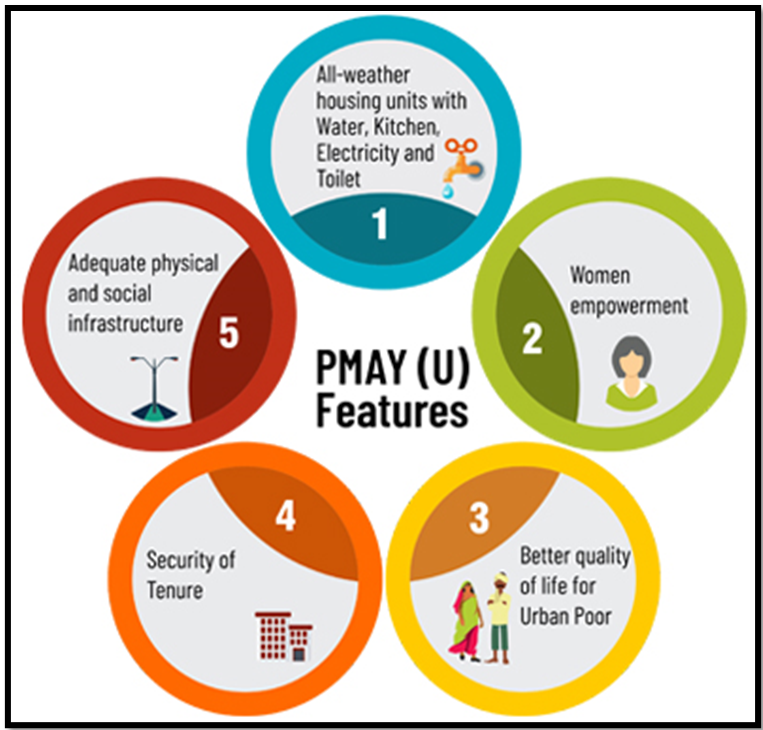AN OVERVIEW OF THE PMAY-U SCHEME
SYLLABUS:
- GS 2: Government policies and interventions for development in various sectors and issues arising out of their design and implementation.
- GS 3: Indian Economy and issues relating to planning, mobilization, of resources, growth, development and employment.
Focus:
- Even though two more years have passed since the supposed completion of the scheme, HfA remains a distant reality.
Mission and Goals:
- The PMAY-U, overseen by the Ministry of Housing and Urban Affairs (MoHUA), addresses the critical shortage of urban housing for economically disadvantaged groups.
- Its primary aim is to provide permanent and durable houses (“pucca” houses) to all eligible urban households.
- Originally set to complete by 2022, the scheme’s deadline has been extended to December 2024 to ensure all sanctioned houses are completed, maintaining the same funding pattern and implementation approach.
Beneficiary Groups:
- The mission targets the urban housing needs of Economically Weaker Sections (EWS), Low-Income Groups (LIG), and Middle-Income Groups (MIG), including slum dwellers.
- EWS families are those with an annual income up to ₹3,00,000.
- LIG families have an annual income up to ₹6,00,000.
- MIG categories are divided into two: MIG I (up to ₹12,00,000 annual income) and MIG II (up to ₹18,00,000 annual income).
- A beneficiary family includes husband, wife, and their unmarried sons and/or daughters.
Key Components of PMAY-U:
- In-situ Slum Redevelopment (ISSR): Provides Central Assistance of ₹1 lakh per dwelling, using land as a resource and collaborating with private developers. Flexibility is given to States/Cities to utilize these funds for other slum redevelopment projects.
- Credit Linked Subsidy Scheme (CLSS): Supports beneficiaries from EWS/LIG and MIG groups in acquiring housing loans with interest subsidies of 6.5%, 4%, and 3% on loan amounts up to ₹6 lakh, ₹9 lakh, and ₹12 lakh respectively. Central Nodal Agencies like HUDCO, NHB, and SBI facilitate this subsidy through lending institutions.
- Affordable Housing in Partnership (AHP): Provides ₹1.5 lakh Central Assistance per EWS dwelling. Projects qualify if at least 35% of homes are designated for EWS, with States/UTs setting price ceilings to ensure affordability.
- Beneficiary-led Individual House Construction/Enhancement (BLC): EWS families can receive up to ₹1.5 lakh for building or enhancing homes. Urban Local Bodies check the veracity of the land ownership, economic status, and eligibility.
Empowerment and Progress:
- PMAY-U promotes women’s empowerment by mandating house ownership in the name of a female family member or jointly.
- As of the latest update, out of 118.9 lakh houses completed under PMAY-U, 76.25 lakh are occupied, demonstrating substantial progress in urban housing provision.
Performance of PMAY-U Verticals
In-situ Slum Redevelopment (ISSR) Vertical:
- Aimed to transform slum areas by providing pucca (permanent) houses to dwellers.
- Only 2,10,552 houses have been sanctioned under ISSR against a much higher demand.
- Slum redevelopment projects often faced issues such as increased living costs for residents and unsuitable housing designs.
- Significant challenges due to land ownership issues on properties owned by government entities like airports and railways.
- Plans often made without community input, leading to mismatched expectations and needs.
Private Sector Participation in Social Housing:
- The scheme heavily relies on private sector participation to fill the gap in public investment.
- However, private sector involvement has faced criticism for prioritizing profit over suitability and affordability.
- Projects sometimes resulted in cramped and impractical living spaces, deterring slum dwellers from moving into new constructions.
- There has been a general lack of enthusiasm from private players due to financial risks and low returns on social housing.
- The approach has resulted in increased segregation and insufficient social housing supply.
Financial Contributions and Expenditure
Centre’s Contribution to Investment:
- The Centre has contributed about 25% of the overall investment in the PMAY scheme.
- Approximately 22.03 lakh crore INR has been invested by the Centre.
- The majority of funding, around 60% or 24.95 lakh crore INR, has been borne by the beneficiary households themselves.
- State governments and Urban Local Bodies have contributed around 21.33 lakh crore INR.
- The structure of PMAY often limits the government’s role to cost-sharing with beneficiaries, especially in the BLC vertical.
| Related initiative
Affordable Rental Housing Complexes (ARHCs):
ANGIKAAR Campaign:
GHTC India:
|
Source: The Hindu
Mains Practice Question:
“Assess the implementation of the Pradhan Mantri Awas Yojana-Urban (PMAY-U) with respect to its objectives of providing affordable housing to the urban poor. Critically analyze the challenges faced by the In-situ Slum Redevelopment (ISSR) vertical and the role of private sector participation in the scheme. Suggest measures to enhance the effectiveness of PMAY-U in achieving its goal of ‘Housing for All’ by the targeted date.”
Associated Articles:
https://universalinstitutions.com/pradhan-mantri-awas-yojana-urbanpmay-u/




